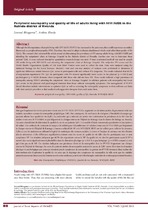| dc.contributor.author | Biraguma, Juvenal | |
| dc.contributor.author | Rhoda, Anthea | |
| dc.date.accessioned | 2013-02-04T08:34:25Z | |
| dc.date.available | 2013-02-04T08:34:25Z | |
| dc.date.issued | 2012 | |
| dc.identifier.citation | Biraguma, J. & Rhoda, A. (2012). Peripheral neuropathy and quality of life of adults living with HIV/AIDS in the Rulindo district of Rwanda. SAHARA-J: Journal of Social Aspects of HIV/AIDS, 9(2): 88-94 | en_US |
| dc.identifier.issn | 1813-4424 | |
| dc.identifier.uri | http://hdl.handle.net/10566/529 | |
| dc.description.abstract | Although the life expectancy of people living with HIV/AIDS (PLWH) has increased in the past years, they could experience secondary
illness such as peripheral neuropathy (PN). Therefore, they need to adapt to chronic disablement which could affect their quality of life
(QoL). The research that informed this article aimed at determining the prevalence of PN among adults living with HIV/AIDS and
attending the outpatients’ clinic at Rutongo Hospital in the Rulindo district of Rwanda. Another aim was to determine these
patients’ QoL. A cross-sectional descriptive quantitative research design was used. A time-constrained method was used to sample
185 adults living with HIV/AIDS and attending the outpatients’ clinic at Rutongo Hospital. The subjective PN screen and the
World Health Organization Quality of Life Scale Brief Version were used to collect the data. Data were analysed using the
Statistical Package for the Social Sciences. Student’s t-test and one-way analysis of variance were performed to determine if
significant differences existed between QoL scores in participants with and without PN symptoms. The results indicated that 40.5%
of respondents experienced PN. QoL in participants with PN showed significantly lower scores in the physical (p ¼ 0.013) and
psychological (p ¼ 0.020) domains when compared with those who did not have PN. These results indicate a high prevalence of
neuropathy among PLWH attending the outpatients’ clinic at Rutongo Hospital. In addition, patients with neuropathy had lower
QoL scores in the physical and psychological domains than those without neuropathy symptoms. The management of PLWH
should therefore include interventions to optimise QoL as well as screening for neuropathy symptoms so that sufferers can liaise
with their medical providers to find medical and supportive therapies that could assist them. | en_US |
| dc.language.iso | en | en_US |
| dc.publisher | Taylor & Francis | en_US |
| dc.rights | © 2012 Biraguma & Rhoda; licensee SAHRA-J. This is an Open Access article distributed under the terms of the Creative Commons Attribution License, which permits unrestricted use, distribution, and reproduction in any medium, provided the original work is properly cited. | |
| dc.subject | Peripheral neuropathy | en_US |
| dc.subject | HIV/AIDS | |
| dc.subject | Quality of life | |
| dc.subject | Rwanda | |
| dc.subject | WHOQOL-BREF | |
| dc.title | Peripheral neuropathy and quality of life of adults living with HIV/AIDS in the Rulindo district of Rwanda | en_US |
| dc.type | Article | en_US |
| dc.privacy.showsubmitter | false | |
| dc.status.ispeerreviewed | true | |
| dc.description.accreditation | Web of Science | en_US |

